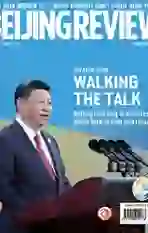The Will to Cooperate
2017-06-08ByLanXinzhen
By+Lan+Xinzhen
China published on May 12 the Initial Actions of the China-U.S. Economic Cooperation 100-Day Plan. The plan, reached after 30 rounds of negotiations between the two nations, listed 10 agreements regarding bilateral economic and trade issues such as China allowing imports of U.S. beef and allowing wholly U.S.-owned e-payment service providers to apply for licenses to operate in China.
During President Xi Jinpings meeting with U.S. President Donald Trump in Florida in April, they agreed to advance China-U.S. economic cooperation with a 100-day plan under the framework of the China-U.S. Comprehensive Economic Dialogue. Following intensive talks between the two sides on key issues, the three co-chairs of the dialogue—Vice Premier Wang Yang of China and Secretary of the Treasury Steven T. Mnuchin and Secretary of Commerce Wilbur Ross of the United States—reached consensus on initial commitments for the plan as well as next-step objectives.
The release of the plan demonstrates both nations confidence in economic cooperation and helps to avert bilateral trade frictions.
Trump had vowed to impose a 45-percent tariff on imports from China and to label China as a currency manipulator during his election campaign, which cast a shadow over Sino-U.S. economic and trade relations and led to fears of a trade war between China and the United States after his election.
However, since taking office, Trump has realized the harm of possible confrontation between the two sides and chosen the smart option of cooperation. Trumps choice has enabled the world to breathe a sigh of relief and injected vitality into Sino-U.S. economic and trade relations. Stable and healthy ties between China and the United States will not only benefi t the two nations, but also boost world economic recovery.
The 100-day plan shows the great importance the Trump administration attaches to mutually beneficial Sino-U.S. economic and trade relations. From the U.S. standpoint, the plan primarily aims to reduce the bilateral trade deficits. Nevertheless, these cannot be solved within a short span of time, given that they result from the two nations different roles in the global economy as well as U.S. restrictions on hi-tech exports. Dialogue rather than friction should be the best way to handle the trade defi -cit issue, and the plan indicates the two sidesresolve and goodwill to solve the problem.
Some suspect that the plan is a concession made by China to the United States. This view is incorrect. The plans 10 agreements show that it is concerned with mutually beneficial economic and trade cooperation. The aspirations of both sides are balanced, and neither side has made any kind of concession under the plan.
Besides the initial results, both sides have also identifi ed other issues that will require great efforts if progress or resolution is to be achieved within the 100-day period. Further, as concrete progress is made in implementing the actions under the 100-day plan, the two sides will begin discussing a one-year plan with the aim to advance their economic engagement and cooperation.
Sino-U.S. economic cooperation conforms to the trend of the times. The 100-day plan proves once again that although new problems frequently emerge in bilateral relations, they can be solved through deepened communication, strengthened coordination and increased mutual trust.
